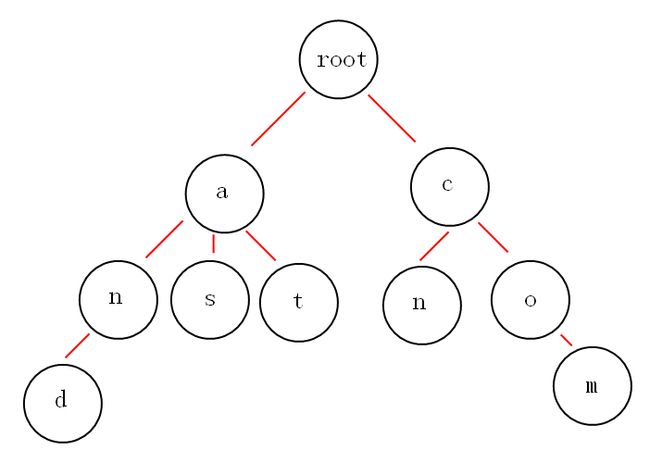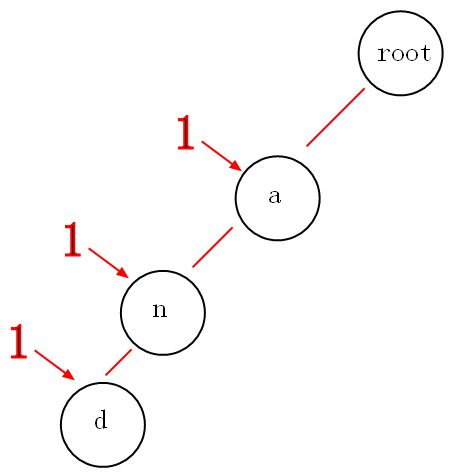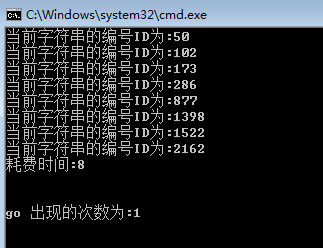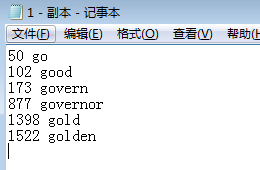很有段时间没写此系列了,今天我们来说Trie树,Trie树的名字有很多,比如字典树,前缀树等等。
一:概念
下面我们有and,as,at,cn,com这些关键词,那么如何构建trie树呢?
从上面的图中,我们或多或少的可以发现一些好玩的特性。
第一:根节点不包含字符,除根节点外的每一个子节点都包含一个字符。
第二:从根节点到某一节点,路径上经过的字符连接起来,就是该节点对应的字符串。
第三:每个单词的公共前缀作为一个字符节点保存。
二:使用范围
既然学Trie树,我们肯定要知道这玩意是用来干嘛的。
第一:词频统计。
可能有人要说了,词频统计简单啊,一个hash或者一个堆就可以打完收工,但问题来了,如果内存有限呢?还能这么
玩吗?所以这里我们就可以用trie树来压缩下空间,因为公共前缀都是用一个节点保存的。
第二: 前缀匹配
就拿上面的图来说吧,如果我想获取所有以"a"开头的字符串,从图中可以很明显的看到是:and,as,at,如果不用trie树,
你该怎么做呢?很显然朴素的做法时间复杂度为O(N2) ,那么用Trie树就不一样了,它可以做到h,h为你检索单词的长度,
可以说这是秒杀的效果。
举个例子:现有一个编号为1的字符串”and“,我们要插入到trie树中,采用动态规划的思想,将编号”1“计入到每个途径的节点中,
那么以后我们要找”a“,”an“,”and"为前缀的字符串的编号将会轻而易举。
三:实际操作
到现在为止,我想大家已经对trie树有了大概的掌握,下面我们看看如何来实现。
1:定义trie树节点
为了方便,我也采用纯英文字母,我们知道字母有26个,那么我们构建的trie树就是一个26叉树,每个节点包含26个子节点。
1 #region Trie树节点 2 ///3 /// Trie树节点 4 /// 5 public class TrieNode 6 { 7 /// 8 /// 26个字符,也就是26叉树 9 /// 10 public TrieNode[] childNodes; 11 12 /// 13 /// 词频统计 14 /// 15 public int freq; 16 17 /// 18 /// 记录该节点的字符 19 /// 20 public char nodeChar; 21 22 /// 23 /// 插入记录时的编码id 24 /// 25 public HashSet<int> hashSet = new HashSet<int>(); 26 27 /// 28 /// 初始化 29 /// 30 public TrieNode() 31 { 32 childNodes = new TrieNode[26]; 33 freq = 0; 34 } 35 } 36 #endregion
2: 添加操作
既然是26叉树,那么当前节点的后续子节点是放在当前节点的哪一叉中,也就是放在childNodes中哪一个位置,这里我们采用
int k = word[0] - 'a'来计算位置。
1 ///2 /// 插入操作 3 /// 4 /// 5 /// 6 public void AddTrieNode(ref TrieNode root, string word, int id) 7 { 8 if (word.Length == 0) 9 return; 10 11 //求字符地址,方便将该字符放入到26叉树中的哪一叉中 12 int k = word[0] - 'a'; 13 14 //如果该叉树为空,则初始化 15 if (root.childNodes[k] == null) 16 { 17 root.childNodes[k] = new TrieNode(); 18 19 //记录下字符 20 root.childNodes[k].nodeChar = word[0]; 21 } 22 23 //该id途径的节点 24 root.childNodes[k].hashSet.Add(id); 25 26 var nextWord = word.Substring(1); 27 28 //说明是最后一个字符,统计该词出现的次数 29 if (nextWord.Length == 0) 30 root.childNodes[k].freq++; 31 32 AddTrieNode(ref root.childNodes[k], nextWord, id); 33 } 34 #endregion
3:删除操作
删除操作中,我们不仅要删除该节点的字符串编号,还要对词频减一操作。
////// 删除操作 /// /// /// /// /// public void DeleteTrieNode(ref TrieNode root, string word, int id) { if (word.Length == 0) return; //求字符地址,方便将该字符放入到26叉树种的哪一颗树中 int k = word[0] - 'a'; //如果该叉树为空,则说明没有找到要删除的点 if (root.childNodes[k] == null) return; var nextWord = word.Substring(1); //如果是最后一个单词,则减去词频 if (word.Length == 0 && root.childNodes[k].freq > 0) root.childNodes[k].freq--; //删除途经节点 root.childNodes[k].hashSet.Remove(id); DeleteTrieNode(ref root.childNodes[k], nextWord, id); }
4:测试
这里我从网上下载了一套的词汇表,共2279条词汇,现在我们要做的就是检索“go”开头的词汇,并统计go出现的频率。
1 public static void Main() 2 { 3 Trie trie = new Trie(); 4 5 var file = File.ReadAllLines(Environment.CurrentDirectory + "//1.txt"); 6 7 foreach (var item in file) 8 { 9 var sp = item.Split(new char[] { ' ' }, StringSplitOptions.RemoveEmptyEntries); 10 11 trie.AddTrieNode(sp.LastOrDefault().ToLower(), Convert.ToInt32(sp[0])); 12 } 13 14 Stopwatch watch = Stopwatch.StartNew(); 15 16 //检索go开头的字符串 17 var hashSet = trie.SearchTrie("go"); 18 19 foreach (var item in hashSet) 20 { 21 Console.WriteLine("当前字符串的编号ID为:{0}", item); 22 } 23 24 watch.Stop(); 25 26 Console.WriteLine("耗费时间:{0}", watch.ElapsedMilliseconds); 27 28 Console.WriteLine("\n\ngo 出现的次数为:{0}\n\n", trie.WordCount("go")); 29 }
下面我们拿着ID到txt中去找一找,嘿嘿,是不是很有意思。
测试文件:1.txt
完整代码:
1 using System; 2 using System.Collections.Generic; 3 using System.Linq; 4 using System.Text; 5 using System.Diagnostics; 6 using System.Threading; 7 using System.IO; 8 9 namespace ConsoleApplication2 10 { 11 public class Program 12 { 13 public static void Main() 14 { 15 Trie trie = new Trie(); 16 17 var file = File.ReadAllLines(Environment.CurrentDirectory + "//1.txt"); 18 19 foreach (var item in file) 20 { 21 var sp = item.Split(new char[] { ' ' }, StringSplitOptions.RemoveEmptyEntries); 22 23 trie.AddTrieNode(sp.LastOrDefault().ToLower(), Convert.ToInt32(sp[0])); 24 } 25 26 Stopwatch watch = Stopwatch.StartNew(); 27 28 //检索go开头的字符串 29 var hashSet = trie.SearchTrie("go"); 30 31 foreach (var item in hashSet) 32 { 33 Console.WriteLine("当前字符串的编号ID为:{0}", item); 34 } 35 36 watch.Stop(); 37 38 Console.WriteLine("耗费时间:{0}", watch.ElapsedMilliseconds); 39 40 Console.WriteLine("\n\ngo 出现的次数为:{0}\n\n", trie.WordCount("go")); 41 } 42 } 43 44 public class Trie 45 { 46 public TrieNode trieNode = new TrieNode(); 47 48 #region Trie树节点 49 ///50 /// Trie树节点 51 /// 52 public class TrieNode 53 { 54 /// 55 /// 26个字符,也就是26叉树 56 /// 57 public TrieNode[] childNodes; 58 59 /// 60 /// 词频统计 61 /// 62 public int freq; 63 64 /// 65 /// 记录该节点的字符 66 /// 67 public char nodeChar; 68 69 /// 70 /// 插入记录时的编号id 71 /// 72 public HashSet<int> hashSet = new HashSet<int>(); 73 74 /// 75 /// 初始化 76 /// 77 public TrieNode() 78 { 79 childNodes = new TrieNode[26]; 80 freq = 0; 81 } 82 } 83 #endregion 84 85 #region 插入操作 86 /// 87 /// 插入操作 88 /// 89 /// 90 /// 91 public void AddTrieNode(string word, int id) 92 { 93 AddTrieNode(ref trieNode, word, id); 94 } 95 96 /// 97 /// 插入操作 98 /// 99 /// 100 /// 101 public void AddTrieNode(ref TrieNode root, string word, int id) 102 { 103 if (word.Length == 0) 104 return; 105 106 //求字符地址,方便将该字符放入到26叉树中的哪一叉中 107 int k = word[0] - 'a'; 108 109 //如果该叉树为空,则初始化 110 if (root.childNodes[k] == null) 111 { 112 root.childNodes[k] = new TrieNode(); 113 114 //记录下字符 115 root.childNodes[k].nodeChar = word[0]; 116 } 117 118 //该id途径的节点 119 root.childNodes[k].hashSet.Add(id); 120 121 var nextWord = word.Substring(1); 122 123 //说明是最后一个字符,统计该词出现的次数 124 if (nextWord.Length == 0) 125 root.childNodes[k].freq++; 126 127 AddTrieNode(ref root.childNodes[k], nextWord, id); 128 } 129 #endregion 130 131 #region 检索操作 132 /// 133 /// 检索单词的前缀,返回改前缀的Hash集合 134 /// 135 /// 136 /// 137 public HashSet<int> SearchTrie(string s) 138 { 139 HashSet<int> hashSet = new HashSet<int>(); 140 141 return SearchTrie(ref trieNode, s, ref hashSet); 142 } 143 144 /// 145 /// 检索单词的前缀,返回改前缀的Hash集合 146 /// 147 /// 148 /// 149 /// 150 public HashSet<int> SearchTrie(ref TrieNode root, string word, ref HashSet<int> hashSet) 151 { 152 if (word.Length == 0) 153 return hashSet; 154 155 int k = word[0] - 'a'; 156 157 var nextWord = word.Substring(1); 158 159 if (nextWord.Length == 0) 160 { 161 //采用动态规划的思想,word最后节点记录这途经的id 162 hashSet = root.childNodes[k].hashSet; 163 } 164 165 SearchTrie(ref root.childNodes[k], nextWord, ref hashSet); 166 167 return hashSet; 168 } 169 #endregion 170 171 #region 统计指定单词出现的次数 172 173 /// 174 /// 统计指定单词出现的次数 175 /// 176 /// 177 /// 178 /// 179 public int WordCount(string word) 180 { 181 int count = 0; 182 183 WordCount(ref trieNode, word, ref count); 184 185 return count; 186 } 187 188 /// 189 /// 统计指定单词出现的次数 190 /// 191 /// 192 /// 193 /// 194 /// 195 public void WordCount(ref TrieNode root, string word, ref int count) 196 { 197 if (word.Length == 0) 198 return; 199 200 int k = word[0] - 'a'; 201 202 var nextWord = word.Substring(1); 203 204 if (nextWord.Length == 0) 205 { 206 //采用动态规划的思想,word最后节点记录这途经的id 207 count = root.childNodes[k].freq; 208 } 209 210 WordCount(ref root.childNodes[k], nextWord, ref count); 211 } 212 213 #endregion 214 215 #region 修改操作 216 /// 217 /// 修改操作 218 /// 219 /// 220 /// 221 /// 222 public void UpdateTrieNode(string newWord, string oldWord, int id) 223 { 224 UpdateTrieNode(ref trieNode, newWord, oldWord, id); 225 } 226 227 /// 228 /// 修改操作 229 /// 230 /// 231 /// 232 /// 233 /// 234 public void UpdateTrieNode(ref TrieNode root, string newWord, string oldWord, int id) 235 { 236 //先删除 237 DeleteTrieNode(oldWord, id); 238 239 //再添加 240 AddTrieNode(newWord, id); 241 } 242 #endregion 243 244 #region 删除操作 245 /// 246 /// 删除操作 247 /// 248 /// 249 /// 250 /// 251 /// 252 public void DeleteTrieNode(string word, int id) 253 { 254 DeleteTrieNode(ref trieNode, word, id); 255 } 256 257 /// 258 /// 删除操作 259 /// 260 /// 261 /// 262 /// 263 /// 264 public void DeleteTrieNode(ref TrieNode root, string word, int id) 265 { 266 if (word.Length == 0) 267 return; 268 269 //求字符地址,方便将该字符放入到26叉树种的哪一颗树中 270 int k = word[0] - 'a'; 271 272 //如果该叉树为空,则说明没有找到要删除的点 273 if (root.childNodes[k] == null) 274 return; 275 276 var nextWord = word.Substring(1); 277 278 //如果是最后一个单词,则减去词频 279 if (word.Length == 0 && root.childNodes[k].freq > 0) 280 root.childNodes[k].freq--; 281 282 //删除途经节点 283 root.childNodes[k].hashSet.Remove(id); 284 285 DeleteTrieNode(ref root.childNodes[k], nextWord, id); 286 } 287 #endregion 288 } 289 }



